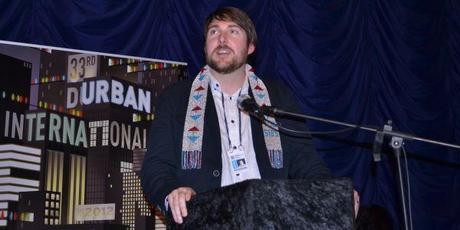
Regisseur Wayne Thornley erhielt im Juli dieses Jahres eine Auszeichnung für den besten südafrikanischen Film beim International Film Festival von Durban
Eigentlich ist Zambezia eine kleine Provinz in Mosambik. Die Triggerfish Animation Studios, beheimatet in Cape Town in Afrika, haben aus Zambezia eine Stadt der Vögel gemacht. Einer Metropole gleich, versammeln sich hier die unterschiedlichsten Gattungen der Luft liebenden Piepmätze. Schaut man sich den Animationsfilm „Zambezia“ an, sucht man zuerst vergeblich den Vergleich zu großen Hollywood Studios, dann aber muss man sich vor Augen führen, dass Triggerfish zwar einhundert der besten afrikanischen Digital Visual Artists beschäftigt, es aber dennoch als Wunder angesehen werden kann, dass ein kleiner Animationsfilm aus den Tiefen Afrikas eine weltweite Kinoveröffentlichung bekommt. Die Filmrezension zu „Zambezia“ findet ihr an dieser Stelle auf filmtogo.net. Regisseur Wayne Thornley hat sich dazu bereit erklärt, per eMail filmtogo.net ein Interview zu geben, welches ihr untenstehend nachlesen könnt.
filmtogo.net: Mr. Thornley, “Zambezia” is your first directing job for a full-length animated movie. It’s your first feature film actually. And it is released worldwide in over fifty countries. How does that feel?
Wayne Thornley: I am surprised, relieved, delighted and amazed that the film has got this far. It’s a wonderful set of emotions to have at the same time!
filmtogo.net: Where did you get the idea for the film?
Wayne Thornley: The original idea was formed some years before I came on to the project. It started out as an exploration of the themes of heritage, homecoming and forgiveness that one finds in the story of the prodigal son. Later we found this blended quite well with the African philosophy of ubuntu, which is often explained as “a person is a person because of other people.” Our hero needs to learn that he can only become fully himself through working with and for others.
filmtogo.net: How did you choose which animals you wanted to show? Why is the focus on birds, not on lions, apes or any other animal? I thought the giraffes looked some kind of funny. I wanted to see more of them. And I think “Zambezia” is a film which wants to show the people a little bit around. So how did you choose that there would be a little scene with giraffes? How did you choose that some animals are not in it and other animals are good, like most of the birds, and other animals are bad, like the Marabous or the Iguana?
Wayne Thornley: We wanted animal characters that would enable us to have sweeping vistas and beautiful, flowing action sequences, so birds were an easy choice. Though we wanted to show off as much of Africa as possible, time and budget meant that we had to choose carefully and include a few iconic animals. Also we really wanted this to be about a particular community with very particular challenges. Visually it was simpler and more striking to centre that story on one type of animal, birds, and to have them threatened by natural bird enemies, iguanas (they love bird eggs). One of the challenges this community faces is that it has excluded a group of its own kind, because that group are considered scavenging thieves. So Marabous as a bird species fit that description quite nicely.
filmtogo.net: You wrote the screenplay with a lot of other guys. How was the work like? Is it easier for you to have a little bit of backup for this kind of work? Or is it like, I don’t know if the saying is known in the entire world: “Too many cooks spoil the broth”? So was it a problem sometimes, working on a script for a film with so many people?
Wayne Thornley: Traditionally, animation is a very collaborative medium. Though it was a delicate balancing act to be sure! Sometimes it felt like there were too many of us and sometimes it felt like there weren’t enough of us. We all had different tastes and sensibilities and since the development process was spread out over a long time, we weren’t always working on it together. Also some of the creative consults were from the US and so there were naturally cultural differences to overcome. The challenge was to draw out the best in each of us and not let the heart of the story get watered down. I’m happy to say we largely achieved that goal. Everyone on the team made important contributions on the road to making the film what it is today.
filmtogo.net: What I was questioning myself was, if this City of Zambezia, where all the birds live, is really that good. There is this military aviation squadron which is all about following orders and doing everything by the book. And the aforementioned Marabous are not allowed in the city because, like they say, they’re ugly. That’s like a two-class society. Is that only an interpretation by me or did you really wanted to scratch on this perfect world of bird-heaven?
Wayne Thornley: You’re exactly right. Our hero learns that the great city, like any community, is messy and flawed, but worth it in the end, if everyone can face up to their “blind spots”. In this case all the birds have to take responsibility for excluding the Marabous, before they can save their city. Our hero also learns that communities must have some order, some rules, in other words, some teamwork, in order to achieve anything important. This is a tough lesson for a little guy who’s used to flying solo.
filmtogo.net: You’ve got a lot of good actors as voices for the characters. How did you get Leonard Nimoy or Samuel L. Jackson? Was there some kind of wariness about an animation film from Africa or were they all convinced from the start?
Wayne Thornley: Our sales agent invited renowned producer, Mace Neufeld, to a test screening in LA and he liked the film. He came on board as an executive producer and really opened doors for us to get the cast we wanted. Also, once the cast saw some of the artwork and clips of animation they were very happy to be involved.
filmtogo.net: How was it like to work with Nimoy, Jackson, but also with Abigail Breslin, Jeff Goldblum and some of your own locals? I mean you’re a first timer and got this huge star power for your film. That must’ve been a good feeling? Or were you intimidated on some levels?
Wayne Thornley: It was a wonderful experience. Of course, I was nervous at first, but they were all really professional and took great care with the work. In the first few minutes of the sessions you realise why each of them is a star, they’re just so good at what they do. In the end it was a lot of fun. Samuel L. Jackson is a very funny man and Jeff Goldblum was nice enough to invite us to watch him play jazz piano at a local LA club.
filmtogo.net: You choose doing “Zambezia” in 3D. What do you think about this 3D-Hype? Is it a technology which you would use in any kind of film or just for animation?
Wayne Thornley: I do think 3D still has to prove it has staying power. I think animation has a slight edge, though, just because of the nature of animated stories these days, they’re often well suited to 3D. It’s also easier to do 3D in animation than in live action, simply because the cameras in animation are all virtual, so they’re always adjustable and always perfect. Zambezia definitely lends itself to 3D, because of the wide open spaces and flying action sequences, and we felt like it would be more striking visually. I’m very happy we chose 3D.
filmtogo.net: What is your fascination with animation? You started as an actor. Then you were doing some tv stuff, I guess. And now you have discovered animation. Why’s that?
Wayne Thornley: I worked as an actor for many years to making a living, but my main ambition was to direct a live action feature film. I spent the early part of my career working towards that goal, but eventually it became clear that directing a feature film in South Africa was going to be next to impossible for many years to come. That’s when I discovered some of the things that were happening in animation in Cape Town. Key people in the local animation scene were really open to new people and after I’d shown what I could do with a short promo, I was suddenly directing animation. In the beginning I was definitely not passionate about animation itself, but I was really excited about the types of stories I might get to tell through animation. I have, in the last few years of making the film, also become really passionate about the process of animation: it’s collaborative nature, the team work required and the way in which a team sticks together for years at a time. The whole culture of animation is quite different to live action and I’ve come to love it.
filmtogo.net: Do you have any kind of role model in the business of animated film? Something like “Hey, what are the guys at Pixar doing? That’s cool.”
Wayne Thornley: To my generation Pixar really are the granddaddies of CG animation. I follow everything they do. Brad Bird and Andrew Stanton were both writer/directors that astound me with their story-telling ability and I’ll listen to anything Ed Catmull has to say on the process of animation. I also really love Aardman. There’s something about them that’s really special and unique. I think Triggerfish can learn a lot from them as a smaller studio making it on the world scene.
filmtogo.net: What holds the future for you? I read that you are developing your follow up film, which is a former idea for a tv show? Can you reveal a little bit about it?


